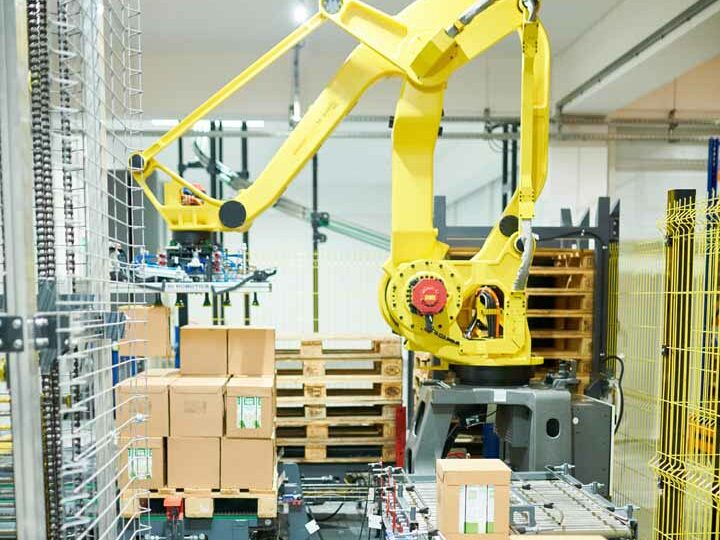How Your Warehouse Can Benefit

Palletizing, pallet stacking, and depalletizing have been key parts of the warehousing and distribution industries for decades. However, the way in which these key tasks are carried out is evolving, keeping pace with developments in technology. Fully automatic robotic palletizing systems were once considered to be far-fetched or overly futuristic solutions — but not anymore.
An automated robotic palletizing system is a production line tool that helps businesses to quickly and efficiently load products onto pallets. These systems generally comprise a high-speed robotic arm. This arm moves product to the pallet in layers in a specific pallet pattern according to the requirements of the business.
The robotic arm is controlled by a robot controller. That controller is programmed to direct the arm to pick up and place the products in the desired pattern. By using an automated palletizing system, businesses can greatly improve their production line efficiency and speed.
A fully automated robotic palletizing system is a solution that uses robotic hardware and computer software to execute palletizing jobs. When items need to be collected together, stacked and palletized, the software programming directs the robot hardware to make this happen.
When a pallet needs to be broken down on arrival at the facility, the software runs a different program to execute this task instead. The more complex the task, the more complex the set of commands required to execute it.
One of the advantages of an automated solution is that it can be integrated into a complete line, which can help to improve cycle times. The actual action of palletization remains unchanged — products are loaded onto a slip sheet and then wrapped and secured, ready for storage or transportation.
The only difference is that human input is removed altogether, and the whole process is handled by an automated solution. This can provide a number of benefits, including increased efficiency, reduced labor costs, and improved safety. In addition, an automated solution can often be customized to specific needs, making it a versatile option for many businesses.
Important highlights from the robotic palletizing systems market are presented below, which shows the market’s notable growth and potential from 2022 to 2032. The data, gathered from a detailed study by Spherical Insights LLP, covers key aspects such as market size, anticipated growth rates, and segments showing promise.
A clear trend can be seen from this data: the automation wave is sweeping across logistics and manufacturing sectors worldwide, signaling an era of increased efficiency and innovation.
How do robotic palletizing systems benefit your facility? The exact benefits depend on the specifics of your business and your use case. However, there are a number of more general benefits, including;
Industrial robotic palletizing equipment is far better suited to repetitive tasks than a team of human personnel would be. Humans are simply not equipped to take care of these roles, which leads to mistakes and errors. These mistakes begin to pile up over time, resulting in significant increases in overall operating costs. Robotic equipment significantly reduces these errors, boosting cost efficiency and reliability in the process.
An automated palletizing solution is significantly more productive than a manual human team. These palletizing systems are able to achieve levels of throughput that would simply not be possible for human operators. They dramatically increase the capability and capacity of your facility.
It’s not just throughput that increases — operational hours can increase too. Automated palletizing, pallet patterns, and stacking solutions can basically run on a round-the-clock basis, with no need for periods of shut-down. Both palletizing and depalletizing processes can be handled whenever required, without delay.
Robotic arm tools and palletizer systems often feature a modular design, making them highly suitable for scalability. If your facility only needs a single robotic arm to handle palletizing on an ad hoc basis, you may decide to simply deploy one solution. When your business grows, and you need your capacity to grow along with it, you can add further robotic modules to suit your requirements.
The safety of human personnel — and of any other visitors on site — is always paramount when it comes to warehousing and distribution. This safety is very hard to guarantee if you have human operators moving around all areas of the warehouse floor. With a palletizer, safety is significantly enhanced, as key areas of the facility are made off-limits when the machine is operational.
Different products have different palletizing requirements. Some items will need to be stacked and bound in a specific way. Some pallets may include several different types of products batched together in one. Robotic solutions can be programmed to handle even the most complex palletizing requirements without delay.
The actual cost of a fully automatic robotic palletizing system will vary according to a number of different factors.
Despite a range of advantages, there may be downsides to using this type of solution in some cases.
Here at PEC, we are among the leaders in this field. We’re ready to help you design and implement the robotic palletizing solution that best meets your requirements. Reach out to our team today to discover more.
X
X
X